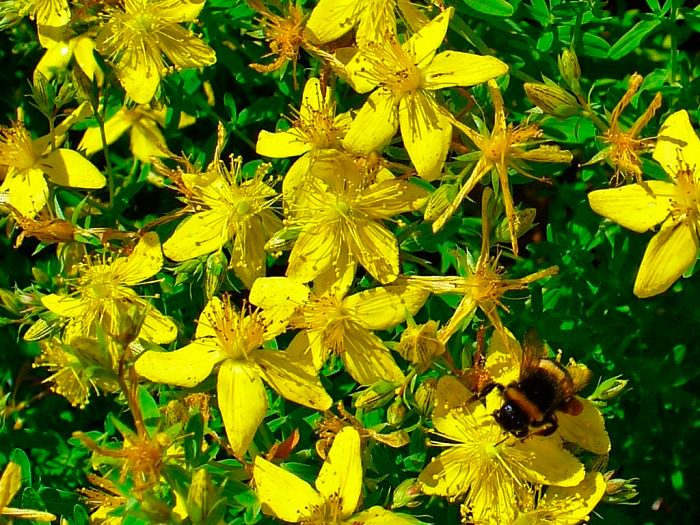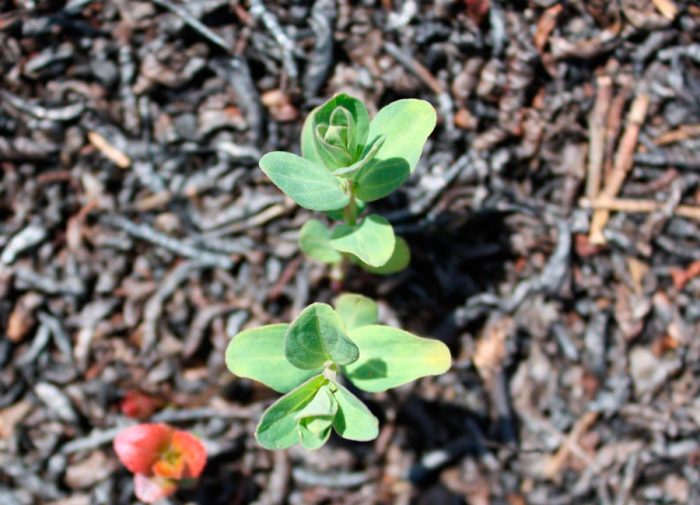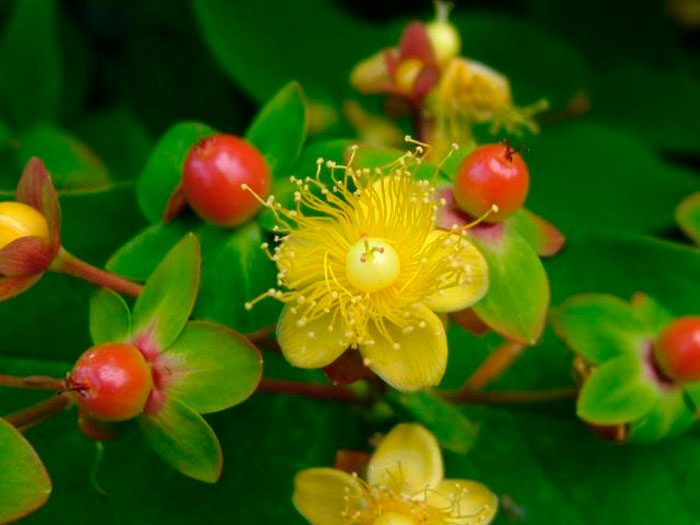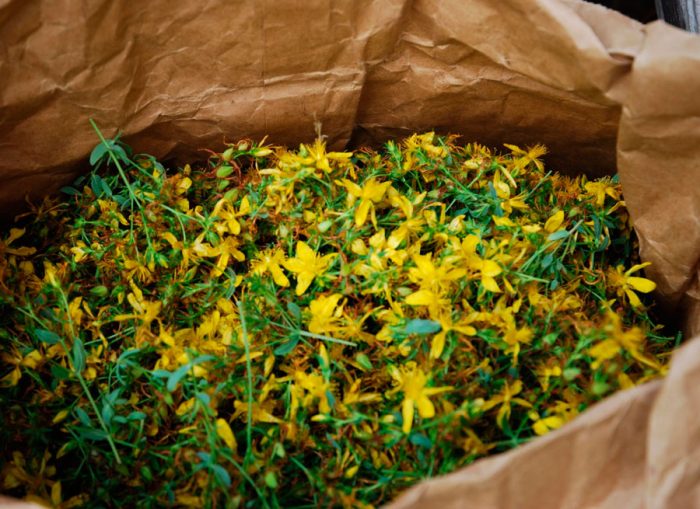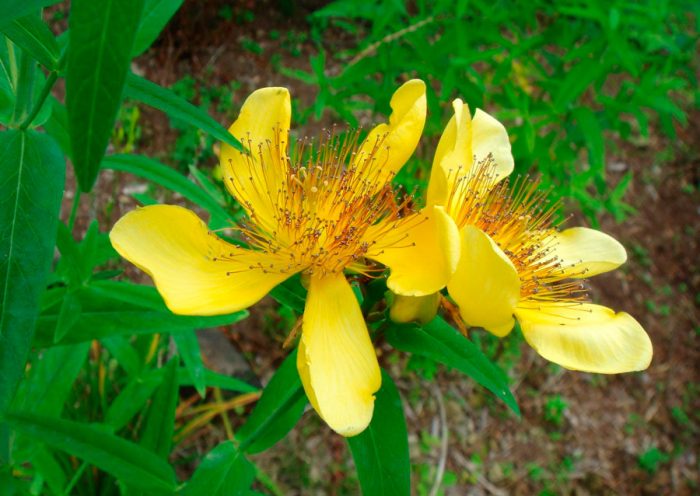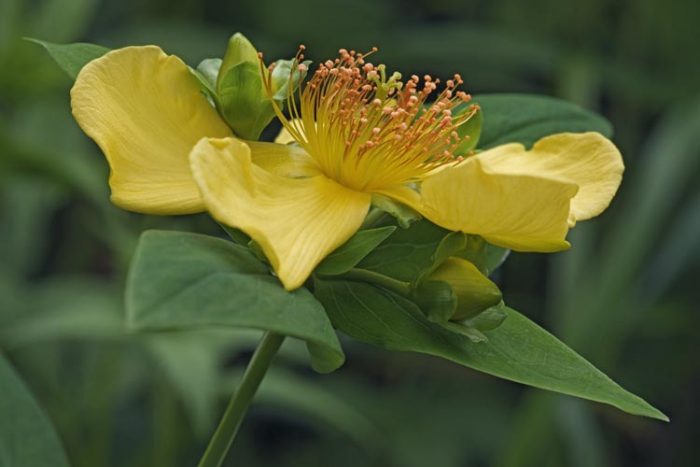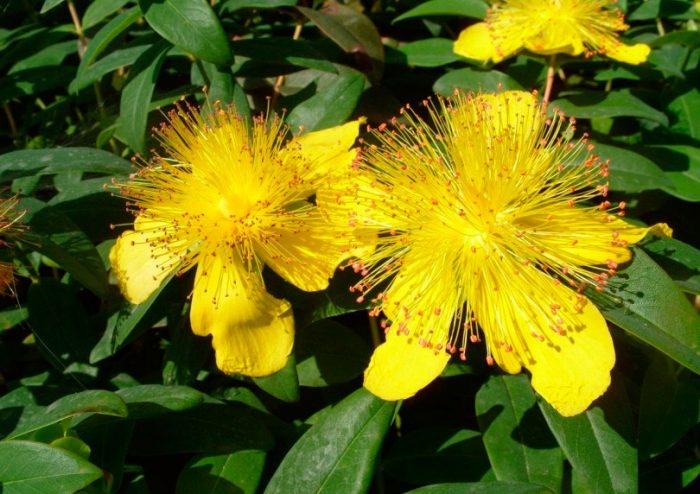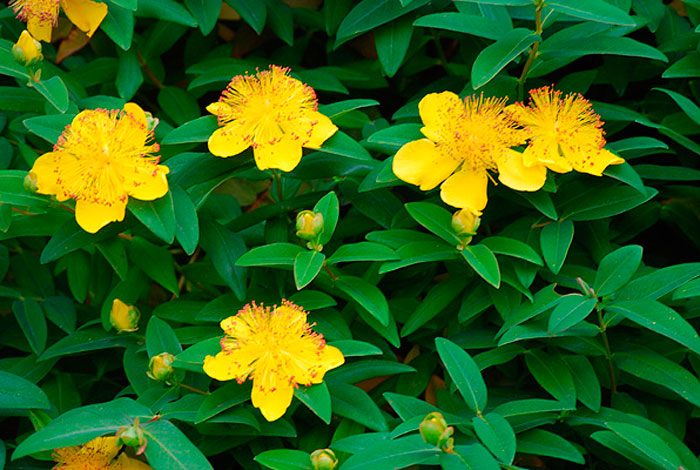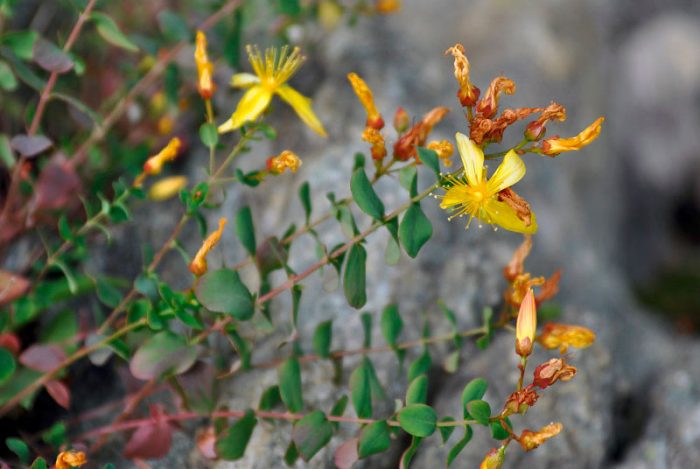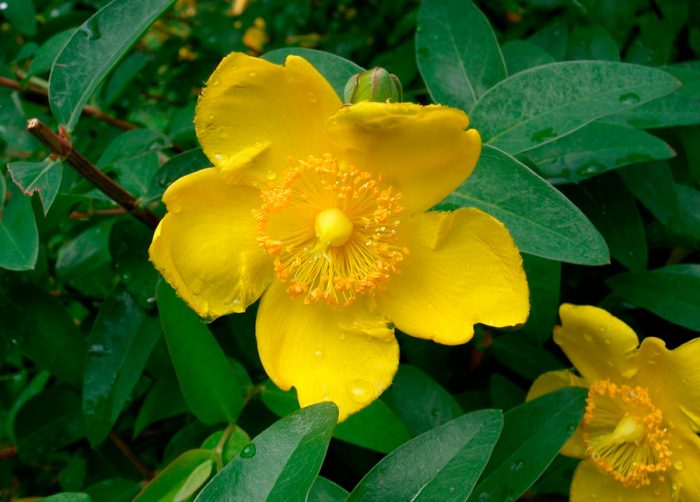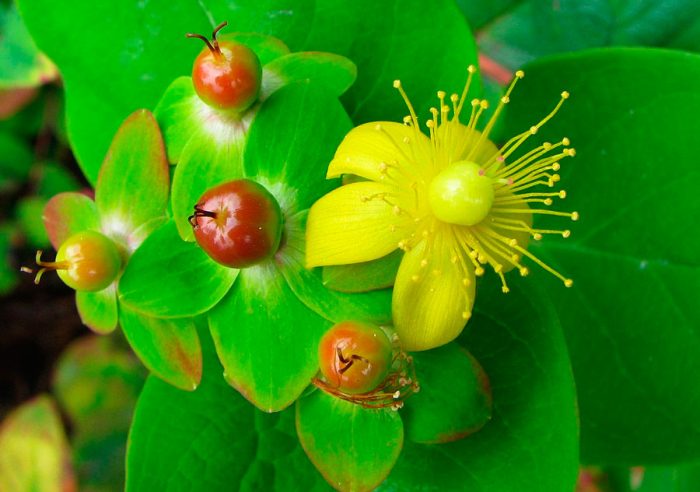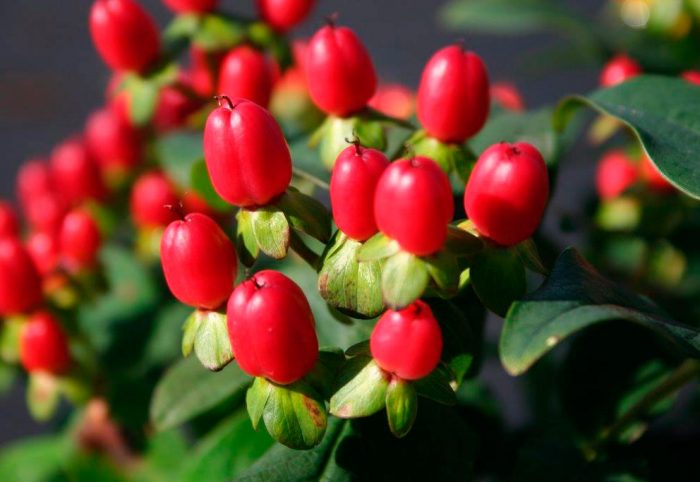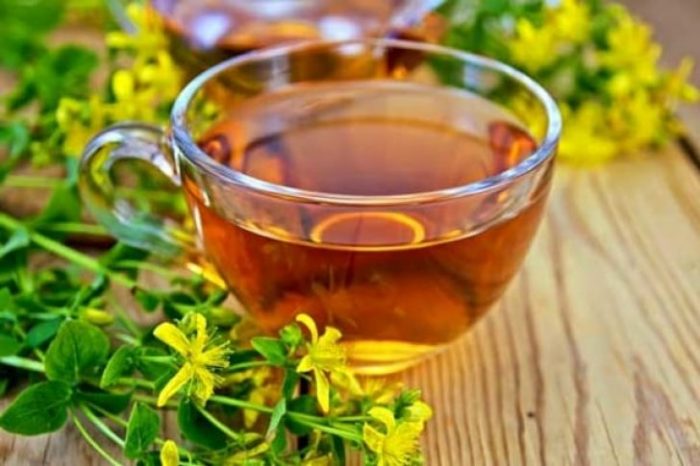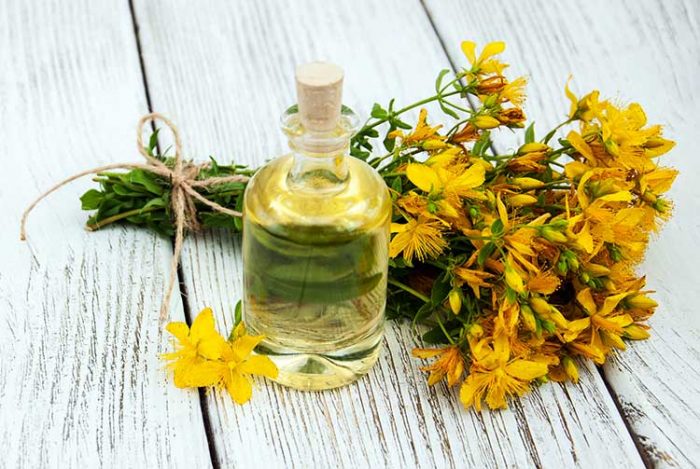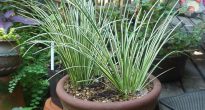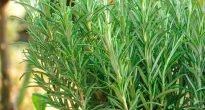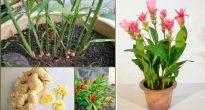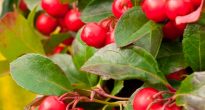The flowering plant St. John's wort (Hypericum) is a member of the St. John's wort family, but previously this genus was part of the Clusia family. Under natural conditions, St. John's wort is found in regions with a temperate climate, and also under the tropics in the southern regions of the Northern Hemisphere. It is very widespread in the Mediterranean. The name of this genus is a romanization of the Greek word, which consists of 2 roots, in translation meaning "about" and "heather". This is due to the fact that St. John's wort is a herb that prefers to grow near heather. This genus unites about 300 species. However, in mid-latitudes in natural conditions, the most common St. John's wort and St. John's wort, or perforated. These species are cultivated, like the evergreen St. John's wort, grown as ornamental plants.
Content
- 1 Features of St. John's wort
- 2 Growing St. John's wort in the open field
- 3 Collecting St. John's wort
- 4 Types and varieties of St. John's wort
- 4.1 St. John's wort (Hypericum ascyron)
- 4.2 John's wort Gebler (Hypericum gebleri)
- 4.3 St. John's wort (Hypericum olimpicum)
- 4.4 St. John's wort (Hypericum calycinum)
- 4.5 St. John's wort (Hypericum nummularioides)
- 4.6 St. John's wort (Hypericum patulum)
- 4.7 St. John's wort (Hypericum androsaemum), or St. John's wort
- 4.8 St. John's wort odorless (Hypericum x inodorum)
- 5 St. John's wort properties: harm and benefit
Features of St. John's wort
St. John's wort, or medicinal, is also popularly called hare blood, St. John's wort, St. John's wort, red grass, blood, ailment, blood man. From a thin, but powerful rhizome, several branched dihedral shoots grow annually, which reach a height of 0.8 m. The green erect shoot gradually acquires a brown-red color shade. On the smooth surface of the stem there are 2 longitudinally located grooves. Opposite sessile leaf plates are entire and have an oblong-ovoid or elliptical shape. They are about 30 mm long and about 15 mm wide. Many glands are located on their surface, due to which the plant is called perforated. Regular flowers of golden yellow color have long stamens that grow together in 3 bunches. These flowers are collected in racemose-corymbose apical inflorescences. Flowering begins in June and lasts 20-30 days. The fruit is a polyspermous trihedral capsule with a mesh surface. The ripe fruit cracks.
Growing St. John's wort in the open field
Planting St. John's wort
Medicinal and garden St. John's wort can be easily propagated by seed. There is nothing difficult in planting and growing this plant. Sowing is carried out at the beginning of spring or in October. In autumn, freshly harvested seeds can be used for sowing. When sowing in spring, the seed will need stratification, for this it must be combined with moistened sand and poured into a glass jar or a plastic bag, which is placed on a refrigerator shelf intended for vegetables for 6-8 weeks. If the sowing was carried out in the fall, then the seedlings in the spring will appear relatively early, while the seedlings will be dense. But if the spring turns out to be sultry or dry, then the appearance of seedlings can not wait at all or they will die. In spring sowing, the plants are characterized by slower development.
The site for planting must be prepared in advance, so, for winter sowing, this is done in the summer, and for spring - in the fall. For sowing, it is recommended to choose a sunny area that has good protection from cold winds. Well-drained soil should be sandy or loamy. The best predecessors of St. John's wort are considered to be onions and carrots. After digging, the soil must be hoed twice, and then the surface of the site is leveled with a rake. When digging, peat compost or rotted manure should be added to the soil (3-4 kilograms per square meter). The prepared soil must be well shed, after which they begin to sow. The seeds are sown in rows, with the row spacing being 15 to 20 centimeters. It is not necessary to bury the seeds in the ground, but they must be sprinkled on top with a thin layer of earth or sand. Then the crops are watered very carefully. If the sowing was carried out in the spring, then to accelerate the emergence of seedlings, it is recommended to cover the area with a film.
St. John's wort care
In the first year of growth, this plant blooms extremely rarely, but despite this, it still needs good care. During the growing season, it is necessary to weed the site at least three times, and it is also necessary to ensure that the soil surface is all loose. Don't forget to water St. John's wort in time. Starting from the second year, the soil must be harrowed in the spring, while last year's shoots must be cut off. Watering is carried out only after the topsoil on the site dries out. If there is a drought and heat, then the number of waterings will need to be increased. If it rains very often in the summer, then you will not have to water this plant at all.
St. John's wort is a perennial that, over the years of its growth, can significantly deplete the soil, as a result of which the yield will rapidly decline and the soil will become poor. To prevent this from happening, you need to regularly fertilize the soil. For top dressing, it is recommended to use Nitroammofosku, it is introduced into the soil at the beginning of the spring period (1 square meter 8 grams), and re-feeding is done before St. John's wort blooms.
This culture is highly resistant to frost, therefore, it is not necessary to cover it for the winter. If a very frosty winter comes out, then the bushes may freeze, but during the next growing season they will recover relatively quickly. In the event that a very cold winter with little snow is expected, then, just in case, it is recommended to cover the area with St. John's wort with spruce branches.
Collecting St. John's wort
St. John's wort will begin to bloom magnificently only 2 or 3 years after the appearance of seedlings. As soon as this happens, you can start harvesting the grass. The collection of raw materials should be done during flowering (from the last days of June to the first - July), and this should be done in sunny and dry weather. During the collection of raw materials, the top 25-30 centimeters of the shoots must be cut off. For this, it is recommended to use a sickle, pruner or a sharp knife, but if the area is very large, then it is better to use a scythe.The collected raw materials must be sent for drying as soon as possible, if this is not done, it will begin to blacken and rot. For drying, the grass is laid out in a semi-dark room with good ventilation, while the temperature should be about 50 degrees. Remember to regularly turn and stir the grass to ensure even drying. As soon as the shoots begin to break easily, and the flowers and leaf plates crumble, we can assume that the drying process is over. The finished raw materials must be laid out in ceramic or glass jars, and you can also use cardboard boxes or paper bags for this. It is necessary to store St. John's wort at an air temperature of 5-25 degrees for 3 years.
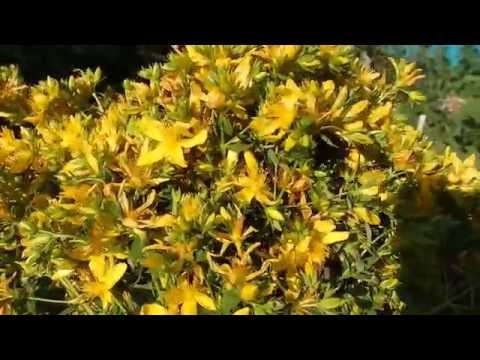

Watch this video on YouTube
Types and varieties of St. John's wort
St. John's wort (Hypericum ascyron)
The homeland of this species is the Far East, Japan, southern Siberia, China and eastern regions of North America. The height of such a perennial plant is about 1.2 m. In the upper part, the tetrahedral shoots are slightly branched. Oppositely positioned entire stalk-enveloping leaf plates have an oblong-ovoid shape, and on their surface there are many translucent glands. The length of the leaves varies from 60 to 100 mm. Their seamy surface has a bluish color. Flowers, up to 80 mm in diameter, are yellow, they are located in 3-5 pieces at the tips of branches, there are also single ones.
John's wort Gebler (Hypericum gebleri)
Under natural conditions, such a plant can be found in Central Asia, Japan, Siberia, China and the Far East. The height of the branchy bush is about 100 cm. Sessile leaf plates can be linear-lanceolate or oblong. At the tips of the stems are rich yellow flowers, the diameter of which is about 15 mm. Flowering begins in July, and it lasts from 35 to 40 days.
St. John's wort (Hypericum olimpicum)
The height of this semi-shrub is 0.15–0.35 m. The shallow root system is quite powerful. Linear elliptical leaf plates have a bluish color. Apical semi-umbellate inflorescences consist of yellow flowers, reaching 50 mm in diameter. Cultivated since 1706
St. John's wort (Hypericum calycinum)
This species comes from the Eastern Mediterranean, Western Transcaucasia and the Balkans. The height of the bush is about half a meter. This evergreen species has leathery leaf plates that have an elliptical or oblong shape. Yellow flowers reach 60–80 mm in diameter, they have a large number of stamens. It has been cultivated since 1676. The Citrinum form is the most popular, its flowers are painted in yellow-lemon color.
St. John's wort (Hypericum nummularioides)
This species is semi-ampelous petrophyte, which means that it prefers to grow on rocks and stones. The height of this dwarf plant is only 5-15 centimeters. There is a large number of slightly branched shoots, which become woody in the lower part. Almost sessile light-gray leaf plates have an oval shape, and glands are located on their surface. The apical semi-umbrellas contain from 2 to 5 flowers.
St. John's wort (Hypericum patulum)
This species is found in Southeast Asia from Japan to the Himalayas. The height of this highly branched evergreen shrub is about 100 cm. Drooping open branches are colored brown. Thin naked young shoots are colored green-red or carmine. Leathery leaf plates are elliptical or ovoid. The small-flowered inflorescences consist of large, rich yellow flowers with many long stamens.
St. John's wort (Hypericum androsaemum), or St. John's wort
In nature, this species is found in Asia Minor, the Caucasus and Western Europe, while it prefers to grow on mountain slopes, in forests and in gorges.This semi-evergreen shrub is fast growing and reaches a height of about 100 cm. Yellow flowers do not represent any decorative value. The unique berry-like fleshy fruits first change their green color to red, and turn black by winter.
St. John's wort odorless (Hypericum x inodorum)
This species is among the most decorative. In such St. John's wort, leaf plates persist for a long time, and large fruits can be colored yellow, green, purple, red, white, salmon or black.
In addition to these species, they are also cultivated such as: St. John's wort, graceful, hard-haired, Kamchatka, multi-leaved, Kalman, honeysuckle, etc.


Watch this video on YouTube
St. John's wort properties: harm and benefit
Useful properties of St. John's wort
The herb St. John's wort contains a large amount of nutrients, thanks to which the plant has medicinal properties. This plant contains rutin, quercetin, nicotinic and ascorbic acids, sugars, saponins, carotene, choline, phytoncides, essential oil, bitter, resinous and tannins. Due to its rich composition, St. John's wort is used to treat a large number of diseases.
This plant is distinguished by antirheumatic, antiseptic, wound healing, choleretic, antibacterial, analgesic, diuretic and antihelminthic effect. It is used in both traditional and folk medicine.
The infusion of this plant, prepared in water, is used in the treatment of rheumatism, colds, diseases of the liver, bladder and stomach, hemorrhoids, enuresis, as well as female diseases and painful sensations in the head. The fact that St. John's wort has medicinal properties has been known for a long time. However, not so long ago, scientists have found that it still has an antidepressant effect, and also has a positive effect on the nervous system. This is a very important finding, because St. John's wort products do not cause the unwanted side effects that chemicals have in abundance.
This plant is also used for inflammatory diseases of the oral cavity (stomatitis, inflammation of the gums, pharyngitis, sore throat), for nervous disorders (insomnia, increased anxiety, depression), for diseases of the digestive system and biliary tract (cholecystitis, hepatitis, diarrhea, dyskinesia, hypotension gallbladder, low stomach acidity, bloating). The pharmaceutical drug Novoimanin, created on the basis of St. John's wort, is used in the treatment of purulent skin diseases (burns, abscesses and infected wounds), sinusitis, inflammation of the pharynx or phlegmon. This drug is very effective, so it even manages to suppress the growth of Staphylococcus aureus, which is resistant to a large number of antibiotics.
In alternative medicine, St. John's wort is used for gastritis, heartburn, heart palpitations, gallstone disease, hepatitis, inflammation of the gallbladder, arthritis, joint pain, sinusitis, alcoholism, mental illness, skin infections. It is also used as a cosmetic product. It works well for dandruff, increased oiliness, cracked heels, acne, baldness, skin laxity and wrinkles.
Most often, this medicinal plant is used in the form of an aqueous infusion, medicinal tea, decoction and alcohol tincture. These funds can be made with your own hands. Herbal preparations are still quite widely used, in which this plant is present.
Recipes
The most popular recipes for remedies that you can make at home with your own hands:
- Infusion... 1 large spoonful of dried herb or 2 large spoons of fresh chopped mixed with 1 tbsp. freshly boiled water. The mixture is removed to a dark place, the infusion will be ready after 3-4 hours.The filtered remedy should be drunk 15 milligrams 3 times a day before a meal. It helps with cystitis, gallstone disease, gastritis, colitis, pain in the head, and is also used to improve venous circulation and to increase blood pressure. Such a remedy is also used to rinse the mouth for mouth infections, as well as for colds. And they make compresses and lotions from it for skin inflammations. When bathing a small child, it is also recommended to pour this product into the bath.
- Decoction... One and a half large spoons of chopped St. John's wort should be combined with 1 tbsp. freshly boiled water. The mixture is poured into a heat-resistant dish (enamel or glass) and placed in a water bath. The product should warm up for 20-30 minutes. (no boiling). It is used for washing, rubbing the skin and rinsing hair, and inside the broth is taken for intestinal disorders.
- Tincture... Vodka (7 parts) or alcohol (10 parts) must be combined with St. John's wort (1 part). The mixture is well corked and stored in a cool and dark place. The tincture will be ready in 3 days. Before taking the product inside, it should be diluted with water (1 teaspoon of tincture per 50 ml of water). Warming compresses are also made from it, which help with muscle and joint pain. The tincture is also used for inhalation and for rinsing the mouth.
- Tea... Pour 1 tsp into the teapot. St. John's wort, after which 1 tbsp is poured into it. freshly boiled water. You can also add strawberries or lime blossom to the drink. This drink does not have medicinal properties, but it is used in order to strengthen the immune system.
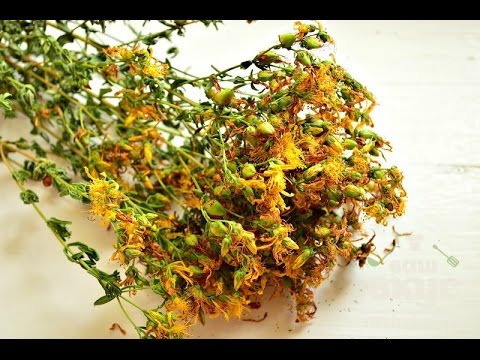

Watch this video on YouTube
Contraindications
This herb and products based on it should not be taken by hypertensive patients during pregnancy. You also need to remember that they cannot be used for a long time, otherwise a not very pleasant taste in the oral cavity, hives or painful sensations in the liver may appear. Long-term use of such drugs contributes to the deterioration of male potency, however, a few weeks after the end of taking St. John's wort, sexual function is fully restored. Also, taking these drugs helps to increase the sensitivity of the skin to ultraviolet rays, in this regard, during the treatment of St. John's wort, sunbathing should be avoided, otherwise burns may appear or dermatitis may develop. An overly strong tea made from this herb can lead to pain in the stomach.


